Late Roman Mosaics at the Institute for Advanced Study
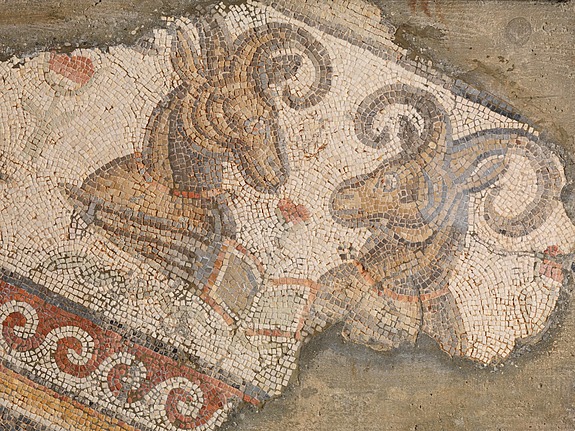
Hanging on the wall at the Institute for Advanced Study are four late antique mosaics from the environs of Antioch, the capital of the Roman province of Syria and one of the largest cities in the Roman Empire. They have been there since Simons Hall was opened in 1971, their geometric patterns a fitting decoration for an institute renowned for math and physics, and their subtle color palette a discreet complement to the exposed concrete of the Brutalist style of the 1960s. At the same time, the intricate designs of these mosaics are vivid testimony to the tastes and craftsmanship of late Roman society. Their migration from the floors of private houses in a Near Eastern city under Roman rule to the walls of a dining hall in a research institute in North America in the twentieth century is a story of affluence, oblivion, and rediscovery.
Excavation
Antioch was founded in 300 B.C.E. by one of the successors of Alexander the Great, the Macedonian general Seleukos I Nicator, who called the new foundation after his father, Antiochos. Under the Roman Empire, it was a flourishing city of 800,000; only Rome, Alexandria, and Constantinople were bigger. It lay fifteen miles upstream from the mouth of the Orontes River in northern Syria in the flood plain at the foot of Mt. Silpios, which rises to the east (Fig. 1). After the First World War, Syria became a French mandate territory, and in 1930 the Syrian Antiquities Service granted Princeton University a concession to excavate at Antioch for six years. A Committee for the Excavation of Antioch-on-the-Orontes was formed in December 1931, representing Princeton University, the Baltimore Museum of Art, the Worcester Art Museum, and the Musées Nationaux de France. Princeton took responsibility for conducting the expedition and publishing the finds. Despite the Great Depression, funds were raised, and on March 4, 1932, in freezing temperatures and lashing rain, excavation began in the straggling town of Antakya on top of the ancient site.
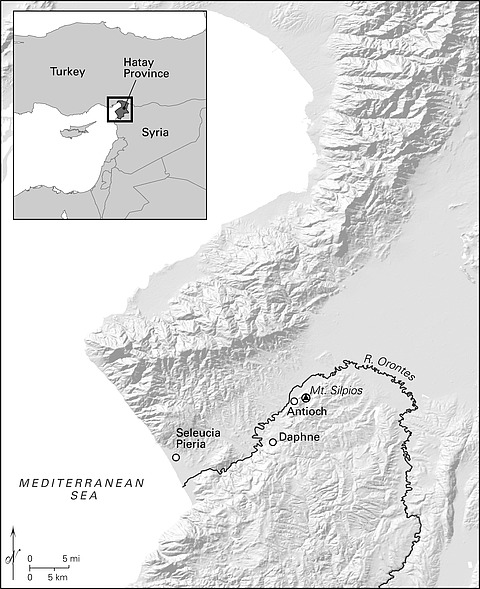
Mud and silt from the Orontes tens of feet deep did not reveal the grand buildings and elegant sculptures for which the excavators had hoped. Instead, they found more than three hundred mosaic floors in houses, baths, and other buildings dating from the period between the mid-first century C.E. and the year 526, when Antioch was destroyed by the last in a series of devastating earthquakes. Upon the expiry of the concession in 1936, the Committee negotiated a renewal for another six years, now extended to include the port city of Seleucia Pieria. Difficulties, both practical and political, dogged the excavation. Cloudbursts repeatedly interrupted the digging, and pumps had to be procured to drain the flooded trenches. An outbreak of malaria required mass transportation of villagers to hospital. Instability in the area intensified, fueled by competing claims to the local province of Hatay by both Turkey and Syria (see Fig. 1). The transfer of Hatay to Turkey in June 1939 posed a special threat to the excavation, since Turkey had more stringent laws than Syria concerning the export of antiquities, although Turkey agreed to honor the terms of the agreement that the Committee had made with the Syrian authorities, whereby half the finds were to remain in Syria and the other half transferred to the institutions represented by the Committee. After eight consecutive seasons, the outbreak of the Second World War caused the excavation to cease.
The excavation diaries at Princeton University, composed by the Assistant Field Director, William A. Campbell, in a factual and unsensational style, give a vivid sense of the atmosphere. Here is the entry for Sunday, June 26, 1938:
Went to McEwan’s dig on Tel Tianat to inspect it for him while he is in Beirut. Found that fighting had occurred in village nearby and that some of his workmen had been killed and injured.
Went with Adib to Seleucia in the afternoon where the uncompleted excavations are being cleaned for photography. While at the temple on the acropolis saw 8 mounted gendarmes and French officers coming up the trail. Workmen immediately became restless and Armenians got ready for action but we soon learned that it was General Huntzinger and party coming to visit the dig.
Returned to Antioch in the evening.
This entry, chosen more or less at random, is typical, with its familiar mention of “Adib” (Adib Ishak, the indispensable secretary to the excavation), its more formal reference to “General Huntzinger” (Charles Huntzinger, 1880–1941, commander-in-chief of the French troops in the Mandate of Syria), and its juxtaposition of one outbreak of violence with a ceremonial visit that nearly caused another. A casual reference to the Syrian-Hittite Expedition in the plain of Antioch, conducted by Calvin E. McEwan for the Oriental Institute of the University of Chicago, conveys the sense of solidarity and mutual support among American teams working at close quarters under challenging conditions in a dramatically foreign culture.

At the end of each season, the mosaics destined for the United States were lifted, backed with a combination of concrete and metal rods (ultimately causing rust to stain some of them), and padded with mattresses and sawdust to be trucked to the coast and loaded onto freighters for their journey across the Mediterranean to the Atlantic and the New World. Under the agreement with the Syrian government, sale of the mosaics was permitted, provided that they became the property of academic institutions. Mosaics from Antioch are now on display across the breadth of the United States, from Harvard to Honolulu. At Princeton University, some can be seen in the Art Museum, Firestone Library, and the School of Architecture; others are in storage.
Acquisition
While the Dining Hall at the Institute was under construction, Princeton University put some of its more modest mosaics up for sale to raise funds for documentation and conservation. The Shelby White and Leon Levy Archives Center holds a list of seven available items dated February 1970. The same list, annotated in the handwriting of Homer Thompson, a Faculty member in the School of Historical Studies (originally the School of Humanistic Studies), is contained in Professor Thompson’s archive at the American School of Classical Studies at Athens. Two figural pieces on the list were passed over in favor of two geometric panels and a stylized pattern of repeating motifs comprising rams’ heads. For the fourth candidate, a figural mosaic was initially chosen, perhaps because it was designed in imitation of a vaulted ceiling and therefore had perspectival interest. But it was subsequently declined in favor of another geometric panel—the largest of the Institute’s quartet—which had already graced an educational institution in Princeton: in 1949–50, it had been lent to Miss Fine’s School on Bayard Lane to decorate the floor of a new gymnasium. When the successor to Miss Fine’s School, the Princeton Day School, moved to a new site on the Great Road in 1965, the mosaic stayed behind and came into the custody of the Borough of Princeton. By 1971 the adjacent area had been damaged by fire and needed renovation, which offered an ideal opportunity for the Institute to purchase the mosaic, pay for its removal, and have it freshly installed in its third home.
Since mosaic consists of so many tiny pieces, it easily suffers damage. Before the Institute’s new treasures could be put on display, they had to be entrusted to the highly specialized job of restoration, for which Frances Follin Jones, Curator of Classical Art at the Princeton University Art Museum, recommended Antonio D. Schiavo of Renaisart Mosaic Co. Inc. in Astoria, New York. The colossal weight of the modern concrete backing on the mosaics posed a further challenge; to meet it, special supports, trims, and brackets sturdy but discreet—were commissioned from Shedaker Metal Arts Inc. in Croydon, Pennsylvania. Altogether, the mosaics, purchased for $4,500, cost another $6,768.31 to remove, repair, and reinstall. When they were at last ready to be hung, their arrangement was decided jointly by the architect, Robert Geddes, and the Director of the Institute, Carl Kaysen, on a walk around the Dining Hall. Over the intervening years, some re-arrangement has resulted in the current disposition. Professor Thompson’s archive contains drafts of an overall description of the mosaics and individual labels for each one, of which two are still on display.
Design
For their original owners, most mosaics in antiquity were not specialized artworks, but durable and attractive floor covering. Their owners could never have viewed them face-on at eye level, as we can, which is the only way to appreciate the overall effect of each design; at best, they could have seen them at an oblique angle by standing at the side of the room. But they could have peered at the details close up, as we must do, also, in order to understand the complex patterns and remarkable optical effects. Being made of tesserae (tiny cubes) laid in mortar, mosaic is a relatively crude medium that cannot replicate the subtlety of a painter’s brush, although the smaller the tesserae, the finer the impression. But the mosaic artists exploited the medium to other ends, juxtaposing their materials—chiefly limestone and marble, with some slate and terracotta and occasional highlights in colored glass—to achieve subtle color gradation, and tracing the outline of individual elements with one or more rows of background-colored tesserae to make them stand out, before filling in the rest of the background in regular lines or curves to make it recede from view. The result can be mesmerizing.
Regional differences in mosaic styles are evident, but basic geometric formats and figural designs are found throughout the Mediterranean world, suggesting that the mosaicists adapted designs from pattern books to fit the shape and dimensions of a client’s space. The plain background against which the Institute’s mosaics are displayed would astonish a Roman audience, who decorated their rooms with frescoed walls and ceilings, as well as mosaic floors. Many mosaics were divided up after excavation, either because they were too badly damaged to salvage intact or because smaller segments were easier to transport and reinstall; geometric designs were obviously more prone to division and separation than figural portions, whose coherence demands that they be preserved complete. All four of the Institute’s mosaics are fragments of larger floors, so we are seeing them not only divorced from their architectural context, but shorn of the rest of the floor to which they originally belonged.
The identifying details of the Institute’s four mosaics, listed in the order in which they are discussed below, are most easily presented in a table:
| House | Sector | Mosaic ID | Description | Date excavated | Size |
|
House of Oceanus & Thetis |
S-17-K |
b685-M155 |
Geometric border |
May 24, 1939 |
0.78 x 2.625 m |
|
House of the Rams’ Heads (DY-247) |
DH-16-N |
c168-M162 |
Geometric panel from room NW of the Rams’ Heads mosaic |
June 10, 1939 |
1.735 x 1.90 m |
|
House of the Rams’ Heads |
DH-16-N |
3535-M41 |
Rams’ Heads mosaic, section 1 |
April 21, 1934 |
|
|
House of the Phoenix, upper level |
DH-29-N |
a881-M116a |
Geometric mosaic in portico NE of Phoenix mosaic |
July 7, 1937 |
2.30 x 1.97 m |
The oldest of the Institute’s mosaics, from the third or fourth century C.E., hangs on the east wall of the Dining Hall on the way to the waste disposal area (Fig. 2). It comprises a nine-foot segment of the outermost border of a paving in the courtyard of a house in Seleucia, S-17-K on the excavators’ grid plan (Fig. 3). The segment looks rather plain, although in its original context it enclosed an inner border—two rows of triangles on either side of a row of ornate cables—that framed a central panel depicting the marine deities Oceanus and Tethys, accompanied by swooping dolphins. The female deity was originally misidentified, which is why the building became known—erroneously—as the “House of Oceanus and Thetis.”
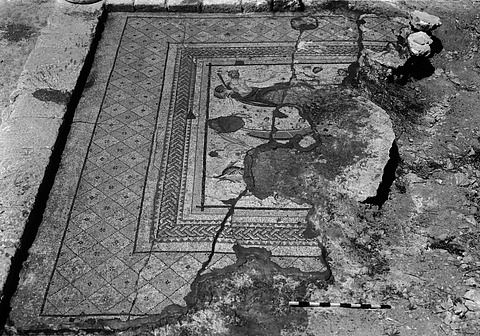
The Institute’s segment comprises a “trellis” design composed of twenty-three squares: two rows of eight cream-colored squares set on the diagonal and outlined in blackish-brown tesserae, with a row of seven beige squares of the same design between them. The straight edges of the mosaic bisect further squares into triangles. Thirteen of the complete squares contain a central motif comprised of twelve blackish-brown tesserae, with a single white tessera in the middle. In the other ten squares, the motif comprises thirteen blackish-brown tesserae with one black one in the middle. There is no discernible pattern in the distribution of these two motifs. It is noteworthy that the beige squares contain a scattering of cream tesserae, but not the other way around, which suggests that the beige tesserae may have been scarce and had to be eked out with cream. The panel is framed on three sides by two rows of black or brown tesserae and two of beige. The segment evidently comes from the corner of a room, since the inner corner of the border is visible on the bottom left, where the trellis design must have continued at right angles to the surviving fragment (see Fig. 2). The original effect of this demure border in muted colors would have offset the central mythological scene in its elaborate frame.
The other two panels on the east wall of the Dining Hall, dating from the fifth or early sixth century C.E., come from the so-called “House of the Rams’ Heads” in the wealthy and salubrious suburb of Daphne (modern Harbiye) in the hills five miles south of Antioch, DH-16-N on the excavators’ plan. The larger fragment hangs to the right of the entrance to the serving area (Fig. 4). The entry for Friday, April 7, 1939, in the excavation diary shows that its discovery occasioned some embarrassment (Fig. 5):
Rashid, the cripple in whose land the first ‘ram’s head’ border was found in 1934, reported a mosaic in his garden. When we inspected the site on this day, we saw to our chagrin that the mosaic must have lain in the same building as the rams (sic) head mosaic since it is of the same level and appears to be of the same period. Although we had trenched all around the rams’ head pavement we had missed it since it lay about a room’s width E. Rashid’s son had found it in the winter by plundering what is apparently the E wall of the structure.
The mosaic was covered & will be excavated as soon as possible.
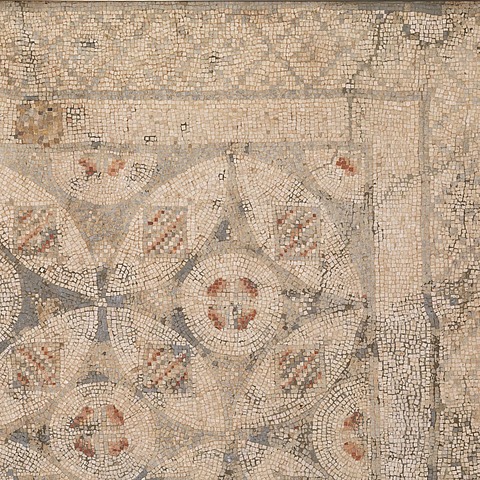
The Institute’s fragment is approximately six feet square and features a geometric design in an overall carpet pattern (semis) consisting of large overlapping circles outlined in white. The oval areas of overlap are white also, with a square in the middle outlined in grey and filled in with diagonal zigzag lines in varying shades of pink, red, grey, white, beige, and green. The center of each circle contains a smaller circle enclosing a “flower” design composed of two intersecting rows of white tesserae with a single black or grey tessera in the middle; each of the resulting quadrants is filled in from the center outwards with successive bands of grey, white, and orange to form “petals” tipped in red. The concave triangles between the larger and smaller circles are filled in with tesserae in two shades of grey—the darker patches may correspond to modern filler—and feature five or more white tesserae arranged in the rough shape of a star; the regularity of these “star” motifs at the bottom left is an obvious clue to restoration.
At the top and on the right, the semis is framed by a broad white border outlined with a double row of grey tesserae on either side. Halfway down on the right, the double row of grey has a kink in it, perhaps the result of two workmen starting from opposite ends and having to take emergency action when their rows threatened not to meet in the middle (see Fig. 4). Beyond this border is another “trellis” pattern, comprising squares on the diagonal outlined with groups of four grey tesserae resembling links on a chain against a cream background. Each square encloses a stylized “star’’ motif composed of a square of four grey tesserae at the center, with three more extending from each corner. The white border at the upper left is interrupted by a patch of grey and brown tesserae that is strongly suggestive of an ancient repair; it was more important to prevent people from tripping in a hole than to make the colors match.
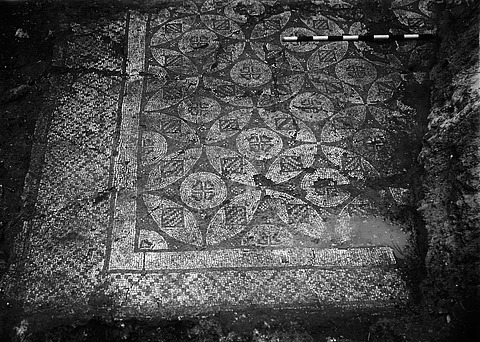
As mentioned in the diary entry quoted above, the second mosaic from this house was excavated in 1934 (Fig. 6). It hangs on the other side of the double doors to the serving area (Fig. 7). It is a segment of a much longer repeating frieze that features pairs of rams’ heads facing each other; hence the name given to the house. The Institute’s fragment, seven feet long, is set on the diagonal in a five-foot frame, to display the surviving portions to greatest advantage and minimize the exposure of what is missing. One pair of rams’ heads is almost intact, except for some restoration to the head and horns of the ram on the right, which is easy to identify when one compares the surviving mosaic with the photograph of it in situ (see Fig. 6). The remnant of another head is visible to the left. The rams’ horns are depicted frontally, their heads are in profile, and their ears—the inner of each pair darker than the outer—mediate between the two perspectives (Fig. 8). Curved rows of tesserae alternating in shades of brown, beige, grey, and green convey the bulge of each ram’s cheek and the shadows cast on his neck by his muzzle. It is worth standing on a chair to examine the rams’ eyes: one grey-green tessera marks the iris; white tesserae represent the white of the eye, interrupted by a single red tessera at the inner corner (displaced in the case of the ram on the left); and the eyelid is outlined with a row of grey-green tesserae resembling eyeliner. A single darker tessera, somewhat haphazardly placed, represents each ram’s visible nostril, and a curved row of black tesserae his lips. Each ram wears a red ribbon, the Persian pativ, around his neck. They make a jaunty pair.
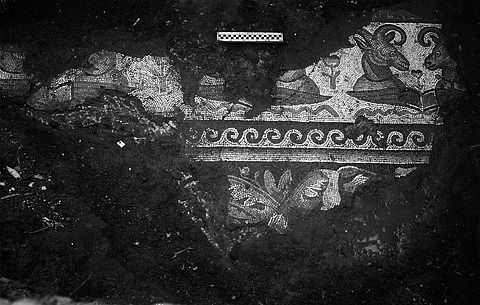
The rams’ heads rise behind a pair of outstretched wings. The central wing rib resembles an open codex (the ancestor of the modern book), the outer edge of each “page” outlined in red, with a white margin surrounding a central “text block” of green. A red flower on a green stalk rises from the spine like a bookmark, and a pair of grey-green ribbons float underneath; another flower, similar but larger, is visible to the left of the pair of rams. A comparable depiction of rams’ heads from the so-called House of the Phoenix, dated to the late fifth century, shows the wing ribs as two confronted “pelta” shapes (single crescents on the outside, double on the inside), which suggests that the codex between the wings of the Institute’s rams may be an extension of this stylized motif, rather than explicitly symbolizing a culture of the book. Rams’ heads are a heraldic symbol of royalty in Sasanian culture. Along with the pativ, they attest Persian influence in the décor of this part of the Roman Empire.

The rams’ heads are depicted on a white background framed by a double row of grey tesserae on either side. Underneath the lower row, an intersecting wave pattern in red and white creates a trompe l’oeil effect, whereby at one moment the red waves seem to surge towards the viewer and at the next moment the white. Below the wave pattern is a border composed of seven rows of tesserae: single rows of grey and red, double rows of orange and yellow, and a single row of white, with some slippage in the distribution of orange and yellow. Underneath, against a black background, there is a luxuriant acanthus scroll, a motif technically known as a rinceau. Shades of green and grey predominate, and the scroll is scattered with red buds. Fruit, cupids, and animals are nestling among the leaves—not visible on the Institute’s fragment, apart from one cupid’s rosy leg—and the multicolored border and the red and white wave pattern are repeated on the other side of the acanthus frieze (Fig. 9). Competing decorative elements that seem to have nothing to do with one another—rams’ heads and scrolling acanthus—are characteristic of the complex framing devices attested at Antioch. Here the acanthus frieze is depicted upside down in relation to the rams’ heads; this may have been intended to solve the problem of perspective, so that one of the borders—either the rams’ heads or the acanthus—would be the right way up, regardless whether the viewer were in the middle of the room or to one side.
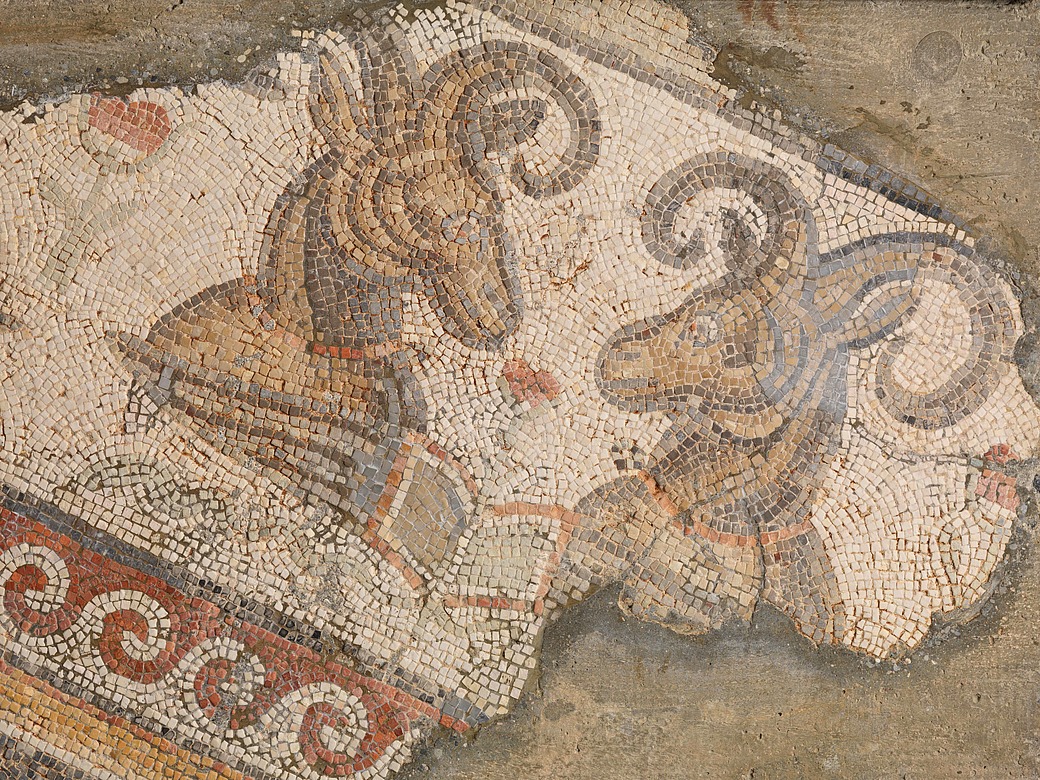
The Institute’s largest mosaic, removed from the gymnasium of Miss Fine’s School, occupies the full height of the north wall of the Dining Hall (Fig. 10). It comes from the House of the Phoenix in Daphne, DH-29-N on the excavators’ plan (Fig. 11). The Institute’s segment comprises a semis with a pattern formed by pairs of interwoven cables: one cable in each pair is composed of parallel rows of black, yellow, and white tesserae with a strand of green on either side, and the other red, yellow, and white, also edged by strands of green. On the surviving fragment, these cables loop around a total of thirty-six white circles against a yellow ground of concave squares. The looping cables give the impression that the circles are tilting to the right. The nine circles at the bottom right each contain a flower in profile formed by one white tessera at the bottom, opening to two in yellow and then three in orange, with six in pink at the top; each flower has a stylized pair of green leaves and a green stalk.
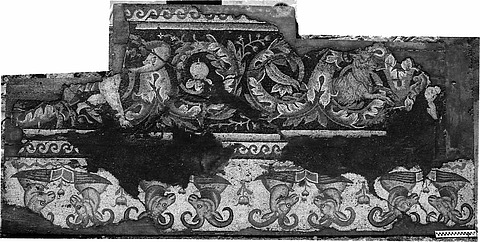
The other twenty-seven circles each contain a “wheel” of concentric circles in red, orange, and white with a dark center; some of the “wheels” have scalloped edges, and two near the top have transformed into squares set on a diagonal. The “wheels” in two of the circles in the lower left quadrant of the semis show obvious signs of restoration: the surface of the tesserae is too smooth, their size is too regular, and they are set too close together. Similarly, some of the black tesserae forming the cables are too shiny to be authentic; they stand out from far away, whereas the original colors are muted, creating a matte effect.
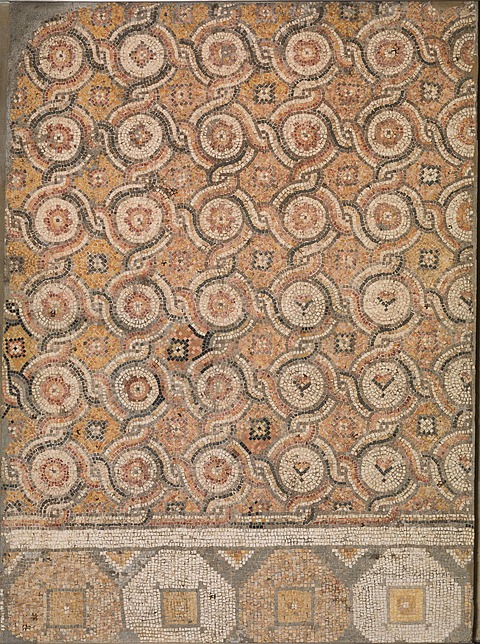
Each segment of the yellow ground on this mosaic features a white square outlined in black and grey tesserae set on the diagonal to create a zigzag edge, with a black tessera in the middle. The cables “tie off” underneath the semis to form a neat “hem.” Five rather uneven rows of white tesserae separate this “hem” from an outer border composed of alternating beige and white octagons; it is notable that the beige is something of an optical illusion, since on closer inspection it turns out to be composed of a scatter of brown, yellow, and cream tesserae in several different tones, with a sprinkling of red among them. The octagons are much larger than the circles formed by the interlocking cables of the semis, but their palette is more muted. Each contains a yellow square outlined in grey, with a motif composed of three grey tesserae decorating each corner, like an elaborate picture-frame. Each square is filled in with two rows of yellow tesserae enclosing two of red; four white tesserae form the center. The triangles left over where the octagons meet the inner border are filled in with four stacked V shapes of decreasing size in grey, white, yellow, and red. To appreciate the displaced sense of gravity that would be created by walking on such a combination of geometric patterns, it is necessary to flip the mosaic over ninety degrees in the mind’s eye.
Scholarship
It seems particularly appropriate that four of the Antioch mosaics have found a permanent home at the Institute, given that the twin monuments of twentieth-century scholarship on Antioch were composed by Institute Members. The seminal publication of the entire corpus of Antioch mosaics was composed while its author, Doro (Teodoro) Levi (1898–1991), was a Member in 1938–39 and again in 1941–45. A definitive account of the history of the city spanning nearly a millennium, A History of Antioch in Syria: From Seleucus to the Arab Conquest, was published in 1961 by Glanville Downey, who was a Member in 1936–40; in 2015, it was reissued as an e-book by Princeton University Press.
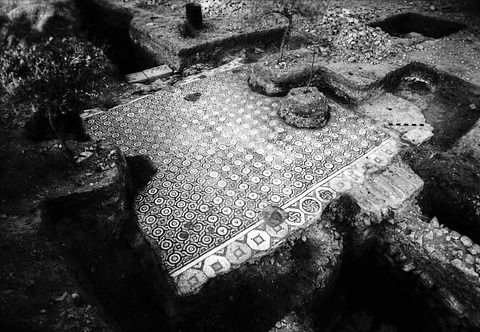
Levi was an eminent classical archaeologist who was forced to flee Fascist Italy. Thanks to the combined efforts of Abraham Flexner at the Institute, Robert Woods Bliss at Dumbarton Oaks, and Royall (“Peter”) Tyler at the League of Nations in Geneva, who was an art historian as well as an economist and a diplomat, Levi found a refuge at the Institute (Fig. 12). In between his two periods of Membership, he taught at Princeton University and at Harvard. He specialized in Greek, Etruscan, and Sardinian art and archaeology, and the eighty-five entries in his list of publications prior to his arrival in Princeton include nothing about mosaics. But the excavation diary for Tuesday, April 10, 1934, records that “Professor Doro Levi, of the Archaeological Museum of Florence, visited the excavations,” and in the Visitors’ Book a handwritten annotation for March 30 is immediately followed by Doro Levi’s card, carefully glued at the top of the next page.
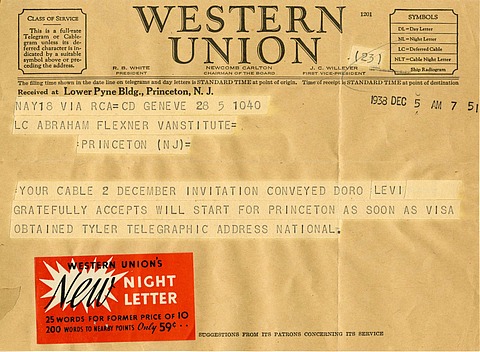
Levi’s monumental work, Antioch Mosaic Pavements, was published in two volumes by Princeton University Press in 1947. It not only catalogues all the mosaics found in the excavation, but also includes a classic 250-page discussion of mosaic technique and style. Travel outside the United States was impossible throughout the Second World War, so Levi worked on the mosaics almost exclusively from such excavation notebooks and black-and-white photographs as were available, much of the archive—as well as half the mosaics—having been left behind in Antioch; those that had been sent to the Louvre he could not see, either, and it is not even clear whether the mosaics that had reached the United States were able to be uncrated for his inspection. Yet, by the end of the war, the project was finished. The foreword is dated March 1945.
It is the privilege of the Institute community to be able to stand in front of mosaics from the environs of Antioch every day. It is easy to imagine Roman children—Greek-speaking, of course, in that part of the Empire—racing the ancient equivalent of dinky cars round the interlocking circles of a semis or down the straight rows of tesserae along the edge of a border. The earthquakes that rocked Antioch have left ripples on the surface of some of the mosaics, indelible testimony to the catastrophe that befell their owners; many of the floors survived only because they were buried by the buildings that collapsed on top of them, to be excavated more than a millennium later as clouds of war gathered over Europe. No other site in the ancient Mediterranean world has yielded such rich testimony to the evolution of mosaic art and craftsmanship over a period of five hundred years. Now each has a different function in a different space. The adornment of the Institute by four modest fragments from this treasury is part of the Roman legacy to the modern world, the old reimagined in harmony with the new.